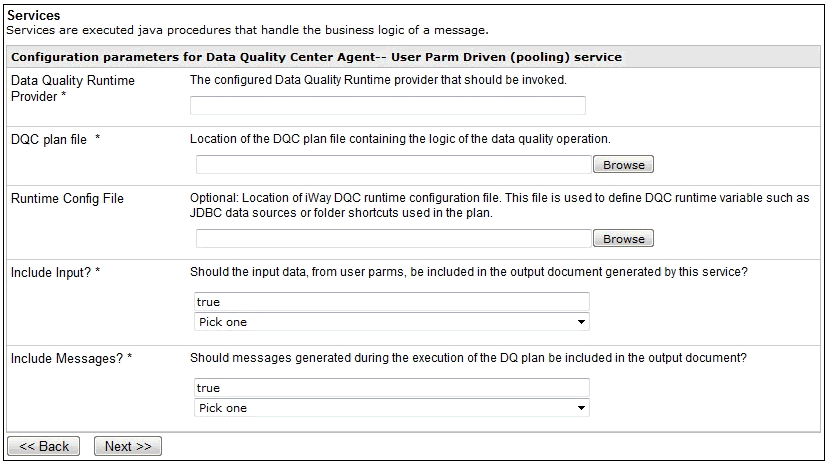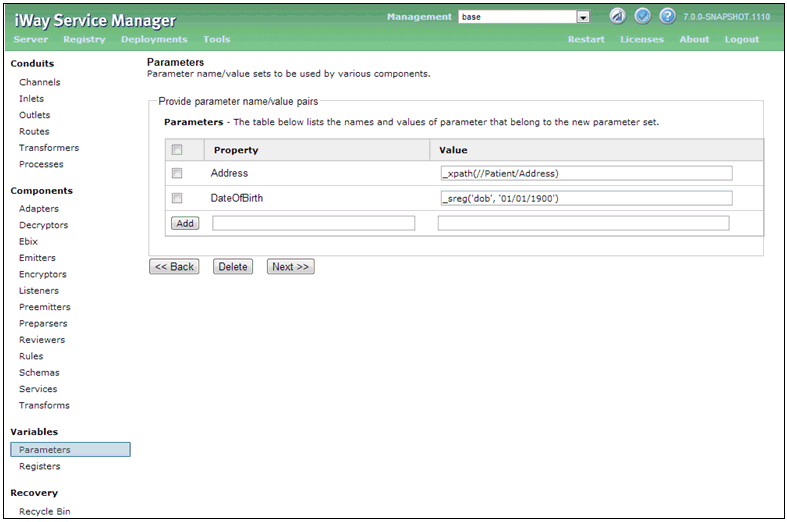Data Quality Center Service (User Parameter-Driven, Pooling) (com.ibi.agents.XDDQAgent2UserParm)
|
Topics: |
Syntax:
com.ibi.agents.XDDQAgent2UserParm
iIT Service Object:
DQS: Data Quality Service Agent - User Parm Driven (pooling)
Description:
This service executes an iWay DQC plan and passes user parameters as input data. The plan is dynamic and called by name.
Parameters:
|
Parameter |
Description |
|---|---|
|
Data Quality Runtime Provider * |
Specify the configured iWay Data Quality Runtime Provider that should be invoked. |
|
DQC plan file * |
Specify the location of the iWay Data Quality Center (DQC) plan file containing the logic for the data quality operation. |
|
Runtime Config File (Optional) |
Specify the location of the iWay DQC runtime configuration file. This file is used to define an iWay DQC runtime variable, such as JDBC data sources or folder shortcuts used in the plan. |
|
Include Input? * |
Determines whether the input data (from user parameters), should be included in the output document that is generated by this service. Select true or false. |
|
Include Messages? * |
Determines whether messages generated during the execution of the iWay DQC plan should be included in the output document that is generated by this service. Select true or false. |
Edges:
The following table lists the available line edges for the Data Quality Center Service (User Parameter-Driven, Pooling) (com.ibi.agents.XDDQAgent2UserParm).
|
Line Edge |
Description |
|---|---|
|
OnError |
Error |
|
OnSuccess |
Success |
|
OnFailure |
Failure |
|
OnCustom |
|
Using the Data Quality Center Service (User Parameter-Driven, Pooling)
|
How to: |
The following image shows the configuration settings pane for the Data Quality Center Service (User Parameter-Driven, Pooling).

The record that is passed to the iWay DQC plan is defined using user parameters. This can be configured using iWay Integration Tools Designer, or you can create a parameter set in the Registry under the Variables section, and then attach the parameter set to the configured service.

The names of these parameters will be passed to iWay DQC as field names and the evaluated parameter values as the field values. Typically, the parameter values will be set using iFL expressions, using special registers or XPath to extract values from the input document of the service. The parameters are treated a single record to pass to the iWay DQC plan.
The service outputs a simple XML document containing the output record from iWay DQC, and optionally including the input record and/or any messages generated by iWay DQC runtime.
For example, you can use this service to invoke the sample (hello_customer) iWay DQC plan.
Procedure: How to Use the Data Quality Center Service (User Parameter-Driven, Pooling) to Invoke a Sample Plan
To invoke the sample hello_customer plan using the Data Quality Center Service (User Parameter-Driven, Pooling):
- Configure a Data Quality Runtime Provider as described
in Configuring
Data Quality Runtime Providers.
For this example, do not be concerned about the pooling options. You can leave the default value, which pools one execution thread. Specify DQRuntime as the name for the Data Quality Runtime Provider. After this provider is created, you must restart iSM.
- Add the Data Quality Center Service (User Parameter-Driven,
Pooling) (com.ibi.agents.XDDQAgent2UserParm) to a process flow.
Specify parameter values for this service as indicated in the following
table:
Parameter
Value
Data Quality Runtime Provider
DQRuntime
DQC plan file
Specify the path to the iWay DQC hello_customer.plan file.
Runtime Config File
<leave blank>
Include Input?
true
Include Messages?
true
- Add the following user parameters to the service:
- firstname
_xpath(//customerGreeting/customers[1]/firstname)
- lastname
_xpath(//customerGreeting/customers[1]/lastname)
Note: The XPath expression specifies that you want the element of the first customer n the input document. Remember, this service only processes one record at a time.
- firstname
- Test the process flow in the configuration where you
created the Data Quality Runtime Provider using the following input
document:
<customerGreeting> <customers> <firstname>Daniel</firstname> <lastname>Deutsch</lastname> </customers> <customers> <firstname>Alain</firstname> <lastname>Perez</lastname> </customers> </customerGreeting>
The resulting output should be structured as shown in the following example:
<?xml version="1.0" encoding="ISO-8859-1" ?> <DQC planFile="c:\working\dqc\hello_customer.plan"> <input> <field name="lastname">Deutsch</field> <field name="firstname">Daniel</field> </input> <output> <field name="greeting">Hello, Daniel Deutsch!</field> </output> <messages/> </DQC>
Note: The input record is included and the document also includes an element for messages. However, since this iWay DQC plan completed without any messages from iWay DQC, there are no messages here.